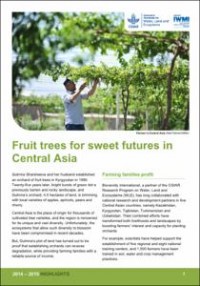Gulmira Sharsheeva and her husband established an orchard of fruit trees in Kyrgyzstan in 1990. Twenty-five years later, bright bursts of green dot a previously barren and rocky landscape, and Gulmira’s orchard, 4.5 hectares of land, is brimming with local varieties of apples, apricots, pears and cherry.
Central Asia is the place of origin for thousands of cultivated tree varieties, and the region is renowned for its unique and vast diversity. Unfortunately, the ecosystems that allow such diversity to blossom have been compromised in recent decades.
But, Gulmira’s plot of land has turned out to be proof that establishing orchards can reverse degradation, while providing farming families with a reliable source of income.
_0_0/index.jpg?itok=T5rreuSn)
Farming families profit
Bioversity International, a partner of the CGIAR Research Program on Water, Land and Ecosystems (WLE), has long collaborated with national research and development partners in five Central Asian countries, namely Kazakhstan, Kyrgyzstan, Tajikistan, Turkmenistan and Uzbekistan. Their combined efforts have transformed both livelihoods and landscapes by boosting farmers’ interest and capacity for planting orchards.
For example, scientists have helped support the establishment of five regional and eight national training centers, and 1,500 farmers have been trained in soil, water and crop management practices.
Some farmers, like Gulmira, have learned how to multiply seedlings and act as mini supply hubs in their own communities. Farmers also act as knowledge hubs that can pass on agronomic techniques such as pruning properly, whitewashing tree trunks to reduce frost susceptibility and using pesticide at appropriate times.
To enable more farmers to get started, researchers have also helped create more than 50 fruit tree nurseries, which are producing more than 1.5 million seedlings of traditional varieties of apple, grape, pomegranate and other fruit trees each year.
Thus, farmer trainings and tree nurseries have helped strengthen local livelihoods – but that’s not all. The traditional fruit trees planted on dry slopes have in several countries managed to visibly restore the local ecosystems and strengthen the delivery of ecosystem services.
Uzbek farmers get a livelihood boost from local fruit tree conservation
Additional benefits for soils and ecosystem services
More than 8,000 plant species exist in Central Asia – Uzbekistan alone is home to 83 traditional varieties of apricot, 43 of grape, 40 of apple, 30 of walnut, 21 of pomegranate and 15 of pear.
In fact, the region can be said to represent a ‘living gene bank’. It is maintaining the genes that allow certain species or varieties to withstand climate change and that enable breeding of other varieties suitable for cultivation.
However, during the past decades, land degradation, erosion and increasing salinity in soils have greatly diminished the native genetic diversity of fruit tree species. This loss of diversity has not only represented a loss in genes, it has also threatened the continued delivery of ecosystem services.
Now, researchers are working to understand how diverse orchards contribute to ecosystem services, such as soil fertility, carbon storage, regulation of pests and diseases, soil water retention and pollination.
First, it is known that planting trees can reverse the accumulation of salt in soils, which occurs in areas with little rainfall and poor drainage. The new orchards have proved to have positive effects on previously saline soils.
Second, scientists are also investigating how inter- and intraspecific diversity within orchards – different species vs. different varieties of the same species - contributes to improving other ecosystem services, including pollination and pest and disease regulation at the field scale, and they are working to share that knowledge with farmers.
To encourage pollination of pistachio trees, for example, researchers recommend that farmers plant both male and female trees in the same plot. Male trees flower for a longer period of time, so a farmer can maximize the benefits of this time frame by planting a mix of female varieties that flower at different times – some earlier, some later. This kind of diversification increases pollination opportunities and consequently improves fruit yields.
/index.jpg?itok=G9_8FuQD)
Potential exists across Central Asia
Bioversity International and its partners continue to promote diverse fruit tree orchards as a solution to multiple challenges. Often, scientists will identify specific areas where farm orchards have the greatest capacity to restore ecosystem services and will then work with regional partners to develop market and non-market incentives that recognize the value of such services.
It is expected that the work to establish orchards and reintroduce a wide variety of fruit tree species will help promote the long-term stability of agricultural production systems in water-scarce environments in Central Asia.
Conservation of fruit tree diversity in Central Asia: Policy options and challenges
Livelihood implications of in situ conservation strategies of wild fruit tree species in Uzbekistan
















